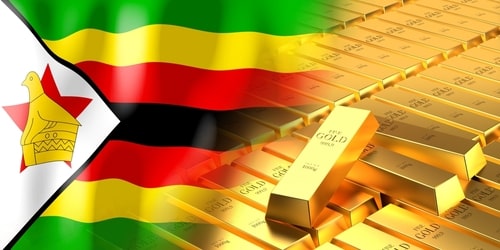
Zimbabwe national flag and gold bullion bars
(Kitco News) Zimbabwe, which has been trying to tame inflation by selling gold coins, is now going a step further. It wants to incentivize the nation’s biggest gold miners to produce above the state-planned targets.
Back in July, Zimbabwe’s central bank started selling gold coins to get inflation under control by providing a store of value to the country’s plunging currency and giving the population an alternative to the U.S. dollar.
One week after kickoff, the country saw strong demand, with the country’s central bank selling 1,500 gold coins and planning to release 2,000 more.
Large miners are now being encouraged by the government to produce more gold. And those who exceed their targets can receive 80% of the payment for the additional output in foreign currency, Bloomberg quoted Deputy Mines Minister Polite Kambamura as saying. The current payment plan is a 60-40 split between foreign and local currency payments.
The country’s gold miners see a larger share of foreign currency earnings as a benefit to sustain their operation costs. Gold exports are currently the third top foreign currency earner, followed by platinum and remittances.
To help the mining industry out, Zimbabwe has selected two local lenders to provide $1 billion worth of funding over the next five years.
Production increases are already being planned by some gold miners, including state-owned Kuvimba Mining House Ltd., which is looking into a fivefold increase in production at its Shamva Gold mine by 2023.
Zimbabwe’s gold output is already up 47% this year, with the government looking for gold mining to account for a third of 2023’s overall mining industry targeted $12 billion revenue, according to Kambamura.
The deal with gold coins
The gold coins being minted and sold by the central bank are one troy ounce 22-carat gold coins called ‘Mosi-Oa-Tunya.’ The name means “Smoke that Thunders,” referencing Victoria falls. Each gold coin has a serial number and can be purchased with local currency, the U.S. dollar, and other foreign currencies.
The price is set based on the international price of gold and production costs. The owners of the gold coins can convert them into cash or trade them whenever needed. The gold coins could also be used for transactional purposes and as a security for loans.
The government’s plan is to use these coins to lower the demand for U.S. dollars following the collapse of the Zimbabwe dollar. Surging inflation and currency devaluation have made things difficult for Zimbabwe’s population. The country’s annual inflation surged 256.9% in July from 191.6% the previous month.
In response to the crisis, Zimbabwe’s central bank was forced to more than double its policy rate from 80% to 200%, a new record.
Zimbabwe also announced plans to adopt the U.S. dollar as legal tender for the next five years to stabilize the country’s exchange rate. But there is a severe shortage of dollars. This is the second time in more than a decade that Zimbabwe is legalizing the greenback as legal tender.
Shared by Golden State Mint on GoldenStateMint.com

















